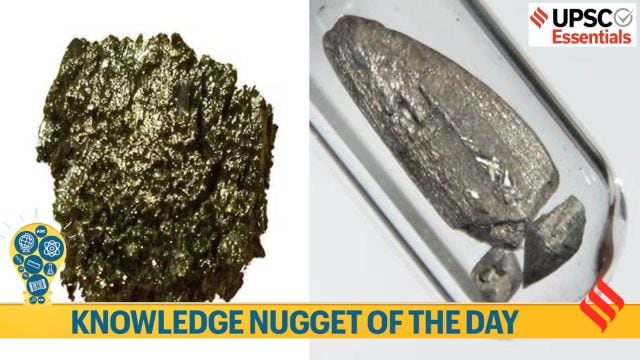
Why in the news?
A proposal by the Trump administration to secure $500 billion worth of profits from Ukraine’s rare earth minerals as compensation for U.S. wartime assistance to Kyiv highlights the strategic importance of these resources. Following the recent meeting between Ukrainian President Volodymyr Zelenskyy, U.S. President Donald Trump, and Vice President J.D. Vance, there is growing speculation that Zelenskyy may face pressure to renew the rare earth elements deal. Given these developments, it is crucial to understand the significance of these minerals.
Story continues below this ad
Key Takeaways :
1. According to an estimate, world’s 5% critical raw materials are currently present in Ukraine. 19 million tonnes of proven reserves of graphite are found in Ukraine which are used in making batteries for the electric vehicles. Lithium deposits, one third of all of Europe’s, lie in Ukraine. Lithium is the main component in making batteries currently.
2. Ukraine also had 7% of world’s titanium production which is utilised in manufacturing aeroplanes to power stations. Though the data pertains to pre-Russian invasion of Ukraine (Feb 2021). Ukraine is also the host of significant deposits of rare earth metals, reported BBC.
What are Rare Earth Elements?
1. Rare Earth Elements (REEs) or Rare Earth Metals are a set of 17 chemical elements in the periodic table — the 15 lanthanides, plus scandium and yttrium, which tend to occur in the same ore deposits as the lanthanides, and have similar chemical properties. REEs are classified as light RE elements (LREE) and heavy RE elements (HREE).
2. The 17 Rare Earths are cerium (Ce), dysprosium (Dy), erbium (Er), europium (Eu), gadolinium (Gd), holmium (Ho), lanthanum (La), lutetium (Lu), neodymium (Nd), praseodymium (Pr), promethium (Pm), samarium (Sm), scandium (Sc), terbium (Tb), thulium (Tm), ytterbium (Yb), and yttrium (Y).
Story continues below this ad
Why are REEs important?
1. REEs are an essential — although often tiny — component of more than 200 consumer products, including mobile phones, computer hard drives, electric and hybrid vehicles, semiconductors, flatscreen TVs and monitors, and high-end electronics. Rare Earth elements are also used in space shuttle components, jet engine turbines, and drones.
2. Scandium is used in televisions and fluorescent lamps, and yttrium is used in drugs to treat rheumatoid arthritis and cancer.
REEs and India
Some REEs are available in India — such as Lanthanum, Cerium, Neodymium, Praseodymium and Samarium, etc. Others such as Dysprosium, Terbium, and Europium, which are classified as HREEs, are not available in Indian deposits in extractable quantities. Hence, there is a dependence on countries such as China for HREEs, which is one of the leading producers of REEs, with an estimated 70 per cent share of the global production.
BEYOND THE NUGGET: National Critical Minerals Mission
1. On 29th January 2025, the government approved a Rs 16,300-crore National Critical Minerals Mission (NCMM) to promote the exploration of critical minerals within the country and at offshore locations. The NCMM will encompass all stages of the value chain, including mineral exploration, mining, beneficiation, processing, and recovery from end-of-life products.
Story continues below this ad
2. The mission will intensify the exploration of critical minerals within the country and in its offshore areas. It aims to create a fast-track regulatory approval process for critical mineral mining projects.
3.Under the mission, an additional Rs 5,600 crore is allocated to the National Mineral Exploration Trust (NMET) to finance risk coverage for foreign sourcing and to support exploration activities outside India.
4. NCMM will receive Rs 1,000 crore from the Anusandhan National Research Foundation (ANRF) and other R&D schemes, and Rs 2,600 crore in budgetary support. The mines ministry had proposed external funding for the NCMM through the World Bank’s Resilient and Inclusive Supply-Chain Enhancement (RISE) initiative.
5. As part of the mission, the government also plans to create four mineral processing parks and prepare separate guidelines for the recycling of critical minerals, with a focus on streamlining India’s massive informal recycling sector. NCMM also seeks to promote Critical Minerals Partnership Agreements with resource-rich countries and to integrate chapters on critical minerals in existing bilateral trade agreements with countries of interest.
Story continues below this ad
6. Critical Minerals approved by Centre: In 2023, the Centre identified 30 critical minerals, including lithium, cobalt, nickel, graphite, tin and copper, which are essential for the country’s economic development and national security.
 30 critical minerals identified by the government
30 critical minerals identified by the government
Post Read Question
Consider the following minerals:
1. Copper
2. Lithium
3. Nickel
4. Cobalt
How many of the above are classified as critical minerals?
(a) Only one
(b) Only two
(c) Only three
(d) All four
Read More:
What are Rare Earths, and why is US military getting involved in their processing?
National Critical Minerals Mission — relevance for UPSC exam
Story continues below this ad
🚨Union Budget 2025 special: Click Here to read the February 2025 issue of the UPSC Essentials monthly magazine. Share your views and suggestions in the comment box or at manas.srivastava@indianexpress.com🚨
Subscribe to our UPSC newsletter and stay updated with the news cues from the past week.
Stay updated with the latest UPSC articles by joining our Telegram channel – Indian Express UPSC Hub, and follow us on Instagram and X.



 30 critical minerals identified by the government
30 critical minerals identified by the government






























